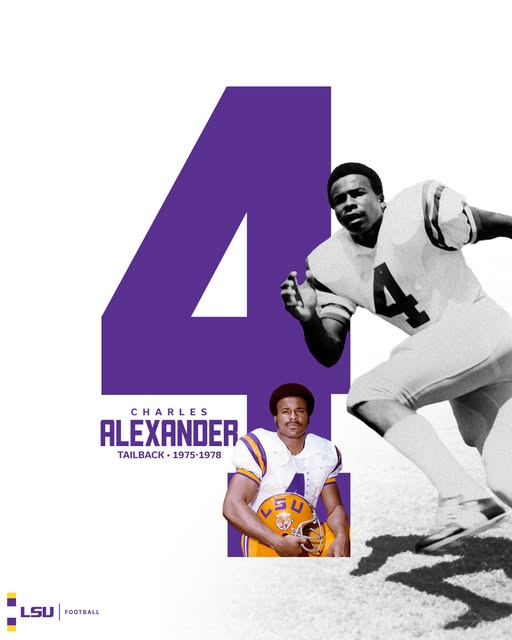Charles Alexander, the man affectionately known as “Alexander the Great,” is finally getting the honor many believe was long overdue. LSU has announced that it will retire the No. 4 jersey worn by its legendary running back, a move that solidifies his place among the pantheon of Tigers greats and cements his legacy as one of the most electrifying players in college football history. For LSU fans, alumni, and football historians alike, the announcement resonates not just as a celebration of athletic excellence but as a nod to a player who embodied the heart and soul of the purple and gold during one of the most exciting eras in program history.
When Charles Alexander arrived at LSU in the mid-1970s, few could have predicted the seismic impact he would have on the program. Standing 6 feet tall and weighing around 210 pounds, Alexander combined size, speed, vision, and uncanny toughness in a way that made him nearly impossible to stop. Over the course of his career from 1975 to 1978, he rewrote the LSU record books and left a lasting impression on every opponent he faced. His 4,035 career rushing yards stood as an SEC record at the time, and even decades later, his name remains etched across numerous school records.
Alexander’s breakthrough came during his junior year in 1977. That season, he rushed for 1,686 yards and scored 17 touchdowns, earning consensus All-American honors and finishing ninth in the Heisman Trophy voting. But it was his senior campaign in 1978 that truly elevated him into college football lore. He ran for 1,686 yards again—matching his junior year total to the yard—and this time was a finalist for the Heisman, finishing fifth. He was once again named a consensus All-American, and he claimed the title of SEC Player of the Year. During that magical season, Alexander set an NCAA record for most carries in a single season with 311 and was the only running back in LSU history to post back-to-back 1,600-yard seasons until Leonard Fournette nearly four decades later.
Beyond the numbers, though, it was Alexander’s style of play that left fans in awe. He ran with relentless power, often carrying defenders on his back for extra yards. But he also had breakaway speed, able to bounce outside and outrun defensive backs for long touchdowns. His stiff-arm became legendary, and his durability and stamina were unmatched in the college game. In an era when the SEC was known for punishing, grind-it-out football, Alexander stood out as a dynamic force who could change the momentum of a game on a single play.
The decision to retire his jersey represents the culmination of years of appreciation for what he meant to the LSU program. While the school has honored him in the past—he was inducted into the LSU Athletic Hall of Fame and the College Football Hall of Fame in 2012—having his number retired is a unique recognition that only a select few Tigers have received. In fact, Alexander will become just the fifth LSU football player to have his jersey retired, joining the likes of Billy Cannon (20), Tommy Casanova (37), Jerry Stovall (21), and Joe Burrow (9). It is an elite fraternity, and Alexander’s inclusion is both fitting and symbolic.
LSU Athletics Director Scott Woodward praised Alexander’s contributions, calling him a “transformative figure in LSU football history.” He noted that Alexander’s records stood the test of time and that his impact went far beyond the field. “Charles was more than a great player,” Woodward said. “He was a leader, a teammate, and a symbol of what it means to be a Tiger. Retiring his jersey is not just about honoring his statistics—it’s about honoring the legacy he left on this program and this university.”
For Alexander, the honor is emotional and deeply personal. Speaking at a press conference announcing the jersey retirement, he reflected on his journey from Galveston, Texas, to Baton Rouge and the many people who helped him along the way. “When I came to LSU, I just wanted to play football and make my family proud,” he said. “I never imagined something like this. To have my number retired—it’s one of the greatest honors of my life.”
Alexander also used the moment to thank his former coaches, teammates, and the LSU fans who supported him during his playing days and beyond. He gave special recognition to his late mother, who encouraged him to chase his dreams despite the hardships they faced growing up. “She believed in me when no one else did,” he said, holding back tears. “This is for her.”
After his college career, Alexander went on to play in the NFL, where he spent seven seasons with the Cincinnati Bengals. Though injuries hampered parts of his professional career, he still managed to rush for more than 2,600 yards and played a pivotal role in helping the Bengals reach Super Bowl XVI in 1982. Even then, his heart never strayed far from Baton Rouge. Over the years, he has remained a visible and active figure within the LSU community, frequently attending games, mentoring young players, and supporting the program in numerous ways.
What makes Alexander’s story so compelling is how seamlessly he bridged generations of LSU football. Older fans remember his dominance in the 1970s as a golden era, while younger fans—raised on stories of Fournette, Clyde Edwards-Helaire, and Derrius Guice—now get to learn about the man who helped set the standard. His jersey retirement is a teachable moment, a chance to connect the program’s rich past with its bright future.
For a program as storied as LSU, the symbolism of retiring a number carries tremendous weight. It signifies that a player’s legacy transcends individual games and seasons. It means that number is no longer just a number—it becomes sacred, reserved for those who gave everything to the university and left an indelible mark on its history. Alexander’s No. 4 will never again be worn on the field, but it will live forever in the rafters of Tiger Stadium, a constant reminder of what greatness looks like.
The ceremony for Alexander’s jersey retirement will take place during LSU’s 2025 home opener, in what is expected to be an emotional and celebratory night. The event will include tributes from former teammates, coaches, and university officials. Fans are expected to pack Tiger Stadium in support, many wearing throwback No. 4 jerseys in honor of the man they call “Alexander the Great.”
As college football continues to evolve, with players now entering the transfer portal at record rates and name-image-likeness (NIL) deals reshaping the landscape, the story of Charles Alexander offers a grounding reminder of what has always mattered most: commitment, resilience, and passion for the game. His legacy isn’t built on hype or flash—it’s built on years of hard work, quiet leadership, and consistent excellence.
You don’t rush for over 4,000 yards in the SEC without being special. You don’t carry an entire program on your back for multiple seasons without being tough. And you certainly don’t have your number retired at LSU unless you are, undeniably, one of the greatest to ever wear the uniform. Charles Alexander is all of that—and more.
In a time when sports often move at breakneck speed, when yesterday’s stars are quickly overshadowed by tomorrow’s headlines, LSU’s decision to retire Alexander’s jersey stands as a powerful gesture of remembrance. It is a statement that some legacies are too significant to fade. Some players are too impactful to be forgotten.
Alexander once said he played every game like it was his last, knowing that every yard he gained meant something more than just a number on a stat sheet. It meant pride. It meant sacrifice. It meant representing LSU with everything he had. Now, with his number rising into immortality inside Tiger Stadium, the school is saying thank you—not just for the touchdowns or the trophies, but for giving LSU fans memories that will last a lifetime.
Charles Alexander, No. 4, is now officially retired. But the legend? That will never fade.



